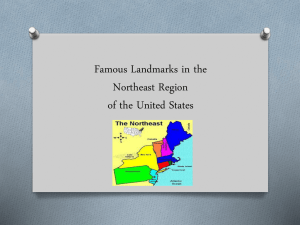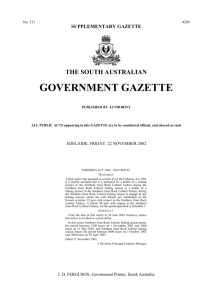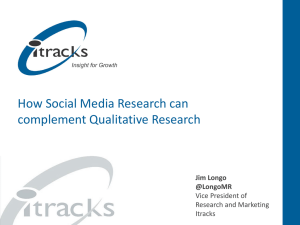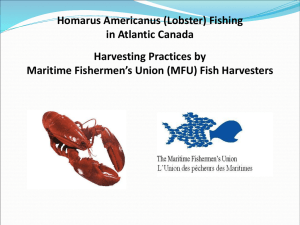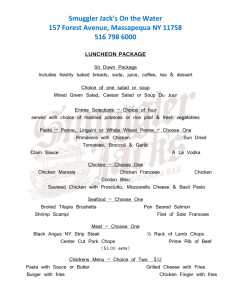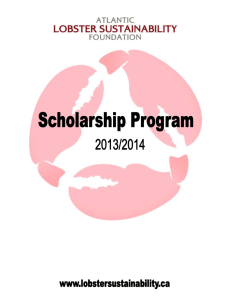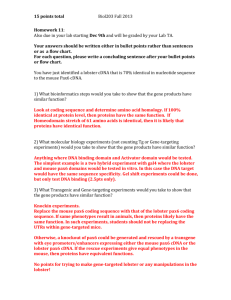Nutrients and the wider environment in lobster cage farming in
advertisement
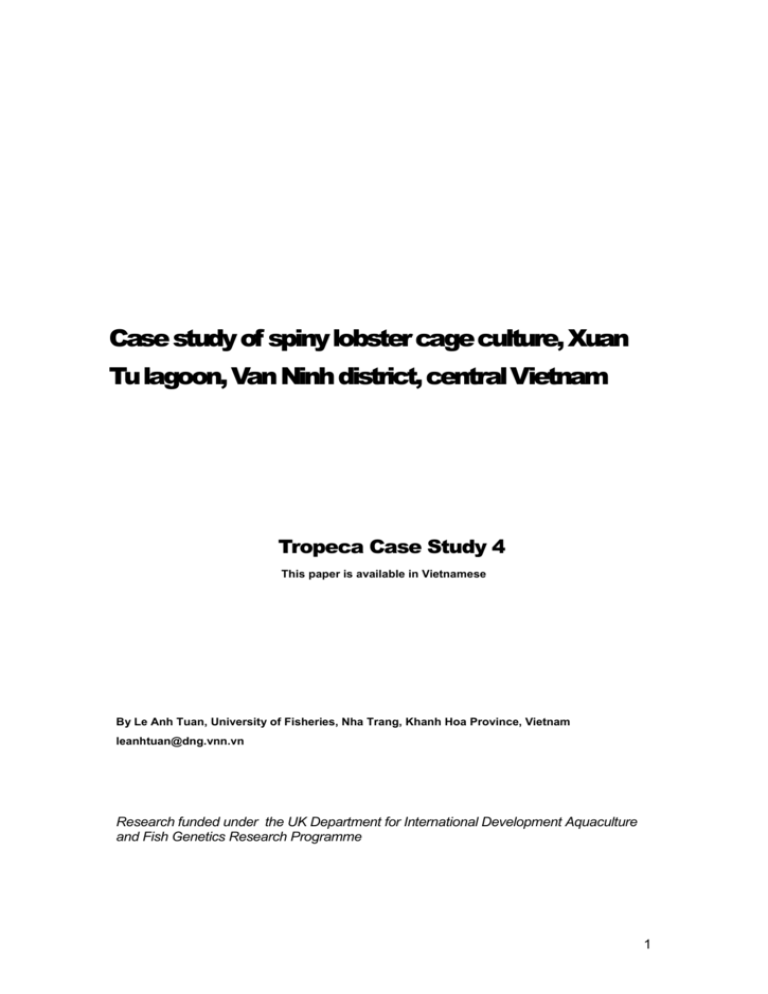
Case study of spiny lobster cage culture, Xuan Tu lagoon, Van Ninh district, central Vietnam Tropeca Case Study 4 This paper is available in Vietnamese By Le Anh Tuan, University of Fisheries, Nha Trang, Khanh Hoa Province, Vietnam leanhtuan@dng.vnn.vn Research funded under the UK Department for International Development Aquaculture and Fish Genetics Research Programme 1 Contents INTRODUCTION .................................................................................................................................. 3 METHODOLOGY ................................................................................................................................. 4 THE STUDY AREA .................................................................................................................................. 4 KEY ISSUES ........................................................................................................................................... 5 WATER QUALITY PARAMETERS ............................................................................................................. 5 SEDIMENT QUALITY PARAMETERS ........................................................................................................ 6 NUTRIENT BUDGETS/SYSTEM HYDRODYNAMICS ................................................................................... 6 RESULTS ................................................................................................................................................ 7 WHAT IS COMING IN, WHAT IS GOING OUT OF THE LAGOON? ................................................................. 7 HOW SIGNIFICANT IS THE LOBSTER FARMING RELATIVE TO OTHER ACTIVITIES AND NATURAL NUTRIENT CYCLING? ............................................................................................................................. 9 IS THERE A PROBLEM? – FOR THE LOBSTER FARMERS; FOR OTHERS SHARING/USING THE WATER ......... 9 APPLICATIONS .................................................................................................................................... 10 REFERENCES ..................................................................................................................................... 12 2 Introduction The spiny lobster (Panulirus) cage farming is one of the most important aquaculture industries on the Southern Central coast of Vietnam. In Vietnam, there are approximately 35,000 lobster cages of which approximately 20,000 cages are located in the coastal waters of the Khanh Hoa province. These marine cages are responsible for approximately 1,500 metric tonnes of products and valued more than US$40 million in 2003. The Xuan Tu lagoon belonging to Khanh Hoa province is a water where lobster farming developed originally in Vietnam. Cultured lobsters in this area are fed exclusively with fresh whole or chopped fish and shellfish. Food conversion ratio for lobster using this diet is high at around 28 (fresh weight basis). Although these cages have been operating for more than a decate, there recently are no studies on environmental capacity associated with the operation of lobster cages. Therefore, there is a need to determine what impacts lobster cages have on the environment and vice versus. 3 Methodology The study area The Van Phong bay is located between the latitude 12o29’ N and 12o48’N and between the longitude 109o10’ and 109o26’ E. It is one of the large, deep and relatively closed bays in Vietnam. The total area of the bay is 503 square km with the areas of its islands of 5000 ha. The bay area with the depth less than 10 m is approximately 30% of the total water surface area (Fig 1). Those made it suitable for cage mariculture, especially for lobster culture. Figure 1. Map of the Van Phong bay and Xuan Tu sea The Xuan Tu lagoon is in the west side of the Van Phong bay. The sea area is approximately 472 ha with the tidal range of 0.8-1.2 m and the average depth of 3.8 m. The water current is maily south-west with the average velocity of 20-30 cm/s. The village population increased over the time. The major population live on lobster farming in recent years. Lobster cage farming started in Xuan Tu lagoon in 1992 and it was profitable and prosperous. Since then many fishermen have invested in lobster cage culture. Lobsters are fed exclusively with fresh whole or chopped fish and shellfish. The most commonly used species/groups for feeding lobster are Lizardfish (Saurida spp); red big-eye (Priacanthus spp); Pony fish (Leiognathus spp); pomfret; snails, oyster and cockles; small swimming crab, other crabs and shrimps. Finfish comprizes about 70% of the diet, with 30% shellfish. The preferred fish (comprizing 38% of fishes in diet) was lizardfish. Food conversion ratio for lobster using this diet is high at around 28 (fresh weight basis). 4 Table 1. Status of population and aquaculture production in Xuan Tu village in recent years. 1998 Population 4582 Lobster farmers/households 395 1999 2000 2001 2002 2003 4720 4829 4915 4996 5100 420 557 560 653 700 10 40 71 Snail farmers/households Shrimp farmers/households 155 120 90 20 20 20 Lobster production (mt/yr) 39.2 45 85 129.6 170 176 0.8 20 35 57.8 54.4 54 Snail production (mt/yr) Shrimp production (mt/yr) 95.2 78.2 68 The snail cage culture has developed in the Xuan Tu sea since 2001. The number of snail cages and the productions for the years of 2001 and 2002 were 30 and 200 cages, and 3 and 20 tones, respectively. The spontaneous development of snail farming caused problems with the water and sediment quality in the area. There was an outbreak of disease that detroyed many snail farms. As a result, there are only 5 snail farmers in the village now in 2004. Similar to lobster farming, snail was fed only trash fish and the FCR was as high as 15. Shrimp farming (Penaeus monodon) has developed for long time due to high profit. However, it wasn’t paid more attention by the local people because of high investment, lacking of land and high risk. There are 20 shrimp farms with an area of 16 ha recently in the Xuan Tu village (Table 1). Key issues Lobster and snail (Babylonia) farming have developed rapidly in the project area. Disease (which until 2000 was not a problem) has increased rapidly in recent years. Water quality has declined, especially close in shore and around the snail cages. Lobster farmers have responded by into deeper water, but are still highly aggregated. Cages in deeper water are more expensive and less convenient, and this has resulted in some conflict with snail farmers. Water and bottom quality are now key concerns for both lobster and snail farmers. There is also some concerns about ongoing shrimp farm development. More general concerns include cost, quality and supply of seed for both snail and lobster farmers, lack of technical support for all the new enterprises. Awareness of environmental issues has been greatly raised through the (on-going) work of an IMA funded project, which has created and seeks to protect a marine protected area (the coral reef in the centre of the Bay) for fisheries conservation/enhancement. There has been significant local support for this initiative, and there seems to be a consensus that benefits are arising. The first local workshop showed that there was strong support for the objectives of Tropeca, and farmers were keen to get involved. Key issues to be addressed by the project included water quality and its relationship with feeding regime and production; and practical guidance on water quality management (snail, lobster, shrimp farmers). Water quality parameters Water samples were collected monthly to investigate the chemical parameters. Samples were collected between 08:00 and 09:00 h at the morning, from two spots: surface and bottom, and inside and outside of each cage. The parameters studied were temperature (C), depth (cm), secchi disc transparency (SDT)(cm), salinity, pH, dissolved oxygen (DO)(mg l -1 ), total nitrogen (total-N) (mg l -1), total phosphorus 5 (total-P)(mg l -1). Water temperature, dissolved oxygen (DO), water pH, and salinity were recorded directly on the spot by a Portable equipment-TOA Water Quality Checker, model WQC-22A (Japan, 1998). Water transparency values were measured by a simple secchi disc. To determine total N and total P, water samples were taken from the cages randomly from a number of spots inside and outside the cages. Water samples were preserved with concentrated H2SO4 in 200 ml PVC plastic bottles and placed in dry ice. The samples were then transported to the laboratory for analyses.The parameters were determined by using a HACH water analysis kit, a direct reading spectrophotometer (DR6000). Standard calibration was plotted and used to validate. Sediment quality parameters To determine the sediment particle size distribution, sediment samples were taken from inside and outside of the cage. For chemical analyses, sediment samples were collected from four randomly selected spots on each cage. Samples were taken using a core sampler, which was designed to trap a column of soil 5 -10 cm deep from the soil-water interface. Samples were preserved in wide-mouthed black bottles and are transported to the laboratory on dry ice. Samples were oven-dried and results were expressed as the total dry matter,T-DM (mg/kg). The soil texture was determined by using Hydrometer method (After Boyd, 1995). Sediment pH was determined from a soil suspension in distilled, de-ionized water (soil:water ratio of 1:5, using a digital pH-meter. Total-P (mg/kg) was measured by the method provided by Olsen (After Boyd, 1995). To determine the total nitrogen, samples were oven dried at 45oC for 2 h and crushed with a mortar.The total nitrogen was determined by using the Kjeldahl method (Nelson and Sommers,1980,1982). The organic content of the sediments (also called loss of ignition) was determined by combustion of samples in porcelain crucibles at 550oC for 12 h in a muffle furnace and the final product of the combustion was expressed as the ash content of the sediment (Clesceri et al.,1989). Nutrient budgets/system hydrodynamics The lobster’s feed including trash fish, ark, clam and crab was calculated assuming 2.10% N and 0.17% P. The snail’s feed including trash fish and crab was calculated to contain 2.54% N and 0.21% P (Boi, 2000). The shrimp grower feed was purchased from Long Thang Company and was labeled to contain 6.62% N and 1.66% P. The estimation of waste load from local households was based on discharge coefficients for solid waste (Sorgreah, 1974), domestic sewage (Padilla, J., L. Castro, A. Morales, C. Naz, 1997), and detergent (Work Bank, 1993). The coefficients of Nitrogen per person per year were 1.86, 4, and 0 for solid waste, domestic sewage and detergent, respectively. Input and discharged of nutrients through water were calculated on the basis of the exchange volume and the respective nutrient concentrations. Nutrient inputs and outputs from stocked and harvest lobster, snail, shrimp were calculated assuming 3.59%N and 0.3%P (Boi, 2000), 1.42% N and 0.11%P (Binh, Pers. Comm.), and 2.9% N and 0.34% P (Jackson et al., 2003), respectively. Inputs of nutrients through atmospheric precipitation, runoff, rainfall, nitrification or nitrogen fixation by blue-green algae and loss through denitrification, volatization or seepage were considered negligible (Briggs and Funge Smith, 1994; Jackson et al., 2003; Md. Shahidul Islam et al., 2004). 6 Results What is coming in, what is going out of the lagoon? The major nutrient inputs (sources) were the feeds for lobster, snail and shrimp and the domestic sewage while the nutrient outputs were mainly final products including lobster, snail, and shrimp (Fig. 2). The nutrient concentration in ambient water was treated together with the acceptable nutrient concentration in relation to the flushed volume and the environmental capacity. Nutrient input and output (m t N/yr) Figure 2. Major nutrient inputs and outputs in the Xuan Tu lagoon 250.0 200.0 150.0 100.0 50.0 0.0 -50.01998 1999 2000 2001 2002 2003 Year Lobster feed Snail feed Shrimp feed Domestic sewage Lobster Production Snail production Shrimp Production The lobster feed and domestic sewage accounted for 59-80% and 30-12% of the nutrient inputs in the lagoon. The contribution of the lobster feed tends to increase over the time (Fig2, Fig. 3), especially in late 2002 and 2003. In general, the nutrient input increased markedly during this time, not only due to lobster feed but also from the snail feed (Fig3). Nutrient input (%) Figure 3. Contributive percentages of different sources 100% 90% 80% 70% 60% 50% 40% 30% 20% 10% 0% 1998 1999 2000 2001 2002 2003 Year Lobster feed Snail feed Shrimp feed Domestic sewage 7 Compared with the significantly increasing nutrient inputs, the nutrient outputs was still at a modest level, and mainly from the lobster prodution (Fig. 2). That is why the environmental capacity of the lagoon for Nitrogen could be exceeded in late 2002 and early 2003 (Fig. 4). Overload (mt N/yr) Figure 4. The overload of Nutrient (Total Nitrogen) in Xuan Tu lagoon by year 100 50 0 -501998 -100 -150 -200 -250 -300 -350 -400 -450 1999 2000 2001 2002 2003 Year This prediction based on calculations using a simple mass balance model seemed to be supported by our surveyed data (Fig. 5). Due to the environmental capacity was exceeded during the time between late 2002 and early 2003, from then on the lagoon could not assimilate all of nutrient inputs. Figure 5. Concentration trends of total nitrogen in Xuan Tu lagoon over time 0.450 0.400 Total N (ppm) 0.350 0.300 0.250 0.200 0.150 0.100 15/01/04 15/07/03 15/01/03 Time 0.050 0.000 7 8 9 10 Station 11 12 15/07/02 13 14 8 How significant is the lobster farming relative to other activities and natural nutrient cycling? The pollution rates, which are expressed as kg N/mt production or per person, for the production of lobster, snail, shrimp and the domestic sewage were 586.34, 366.58, 70.36, and 5.86 (Adapted from Sorgreah, 1974; Work Bank, 1993; Padilla, J., L. Castro, A. Morales, C. Naz, 1997; Boi, 2000; Jackson et al., 2003; Binh, pers comm., 2004), respectively. The pollution caused by the farming of lobster, snail, and shrimp and the domestic sewage over the time was shown in the figure 6 below. Figure 6. The pollution caused by aquaculture activities and domestic sewage in Xuan Tu lagoon Pollution (mt N/yr) 250.0 200.0 150.0 100.0 50.0 0.0 1998 1999 2000 2001 2002 2003 Year Lobster Snail Shrimp Domestic sewage Oviously, lobster farming was the major factor contributing to the pollution of the lagoon with a nutrient (total nitrogen) loading more than 150 tones a year recently. Additionally, the pollution contribution from the local population was as high as approximately 30 tones a year. Shrimp and snail farming contributed small parts to the pollution. However, the increasing of snail farming in the period of 2002-2003 sped up the exceeding of the environmental capacity in the lagoon. Is there a problem? – for the lobster farmers; for others sharing/using the water In the past, lobster diseases rarely occurred. Recently however, culturing in poorer quality water (due to rapid increase in number of cages) have resulted in some diseases in cultured lobsters in the lagoon. The common diseases were black gill, shell necrosis, and red body. Some preliminary studies showed that the main pathogens occurring in infected lobsters were: 2 bacteria Aeremonas hydrophyla and Proteus rettgeri, 2 fungi Fusarium solari and Lagenidium sp; and some parasites Baranus spp, Zootharinium, Vortiella (Lieu, P.T.T, 2003). Besides, the growth rates of the cultured lobster were reduced markedly compared with those in previous years (Muoi, pers. Comm., 2004). Water and bottom quality are now key concerns for both lobster and snail farmers. 9 Management implications: individual farms; groups of farms; other activities The lobster farms in Xuan Tu lagoon may be divided into two groups: failed cages and successful cages. The management regimes and some other characteristics showed that there were some differences between the two groups (Table 2). Therefore, regarding to improving the environmental capacity of the lagoon, there are some management implications as follows: - - - Cage design: larger and off-bottom cage seemed to be better; Location: should be far from shore and in deeper area where there is good flushing rates; Feeding practice: should be improved through reducing feeding frequency and feed amount if possible; Left over: the un-eaten feed should be removed out of the lagoon instead of out of their own cages but still in the lagoon, and in a shorter duration instead of overnight time as usual; Practical indicators: lobster cages should not operated if their sediment has a darker colour, and very off-flavor, especially when the bottom organisms are mainly polychaet. Groups of farms: should be re-arranged in a way that facilitates better flushing rates; Other activities: snail farming practices in the lagoon were similar to those of lobster farming, therefore, snail farmers may improve their management through lobster farmers. Improve the common environment, the shrimp farmers need to treat the sludge discharged from shrimp ponds before releasing into the lagoon. Additionally, domestic sewage should be treated in the same way. Table 2. Generalized scenario of management regimes in selected lobster cages Issues Cage type Cage shape and size (m) Frame Net bag Bottom Depth (m) Distance from shore Source of fry Stocking density (individuals/cage) Rearing period Feed used Feeding regime FCR Sediment colour Sediment smell Bottom organisms Cumulative mortality Survival rates Applications Failed Cages Fixed cages Rectangular, 3 x 3 x (1.5-4), 3 x 4 x (1.5-4); Salt-resistant wood, vertical wood: = 15-20 cm; horizontal: = 7-15 cm outer net: 2a = 20-50mm; inner: 2a = 2-4mm (fixed) On or off-bottom (~ 0.5 m) <4m Close (<1000 m) Wild 100 18 - 20 months Trash fish, ark, clam, crab 200g-lobster: twice a day; feed with out shell > 200g-lobster: 1-2 times/day: 30% in the morning, 70% in the afternoon; feed with shell 28-30 Darker Off-flavor Mainly polychaet 30 -100% 0 - 70% Successful Cages Fixed and floating cages Rectangular, 3 x (3-4) x (1.5-4), 3.5 x 3.5 x 3.5, 4 x 4 x 4 Salt-resistant wood, vertical wood: = 15-20 cm; horizontal: = 7-15 cm and buoys (if floating cages) outer net: 2a = 10-15mm (floating) or 20-50mm; inner: 2a = 2-4mm; Off-bottom (> 0.5 m) >4m Far (>1000m) Wild 100 18 - 20 months Trash fish, ark, clam, crab 200g-lobster: twice a day; feed with out shell > 200g-lobster: 1 time/day; 100% in the afternoon; feed with shell 20-30 Brighter Normal Mainly molluscs 05 - 30% 70 - 95% 10 Production (kg /cage) - < 70 > 70 Management agreement: should be established among the local communities because aquaculture contributed 90% to the village’s economy. 11 References 1. Boi, N.V.Q., 2002. Lobster (Parulinus ornatus) cage culture practices and the potential environmental impacts of feed use in Van Ninh district, Khanh Hoa province, Vietnam. Master thesis, AIT, Bangkok, Thailand. 2. Tuan, L.A., Nho N.T., and J. Hambrey, 2000. Status of Cage Mariculture in Vietnam. In Cage Aquaculture in Asia: Proceeding of the First International Symposium on Cage Aquaculture in Asia (ed. IC Liao and C.K. Lin), pp. 111-123. Asian Fisheries Society, Manila, and World Aquaculture Society - Southeast Asian Chapter, Bangkok. 3. Tuan, L.A., 2004. Present status of lobster cage culture in Vietnam. Proceeding of the ACIAR lobster ecology workshop, 24-30. Institute of Oceanography, Nha Trang, Vietnam. And???? 12

